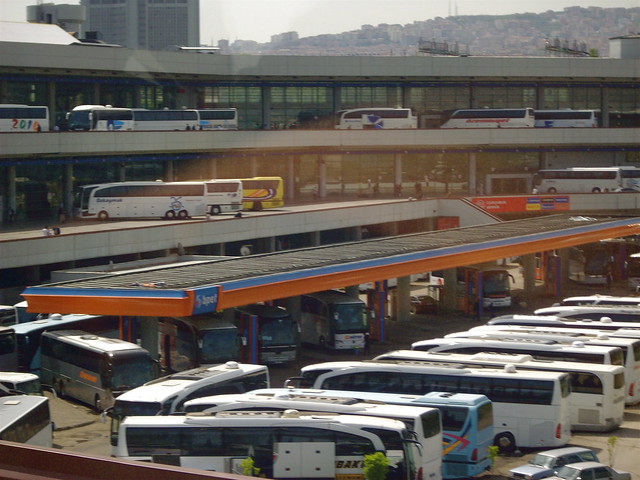

Once you get into the details, there are so many things that are different about Turkey’s shared transport system from Ottawa’s that it’s difficult to know where to start. For example, in Ankara, there are two kinds of buses those for passengers with passes called ‘ego’ and those cash fare – only buses. The cash fare buses have conductors which from an Ottawa perspective seems unnecessary, but when you see a full-on transit system operating at capacity 18 hours a day, it’s a whole different thing.
Consider that an articulated bus costs more than half a million dollars. An Ankara conductor can load 25 people faster than it can take an Ottawa bus driver to load two passengers looking for change or one mother with a stroller. The speed differential at bus stops is phenomenal. I’d guess it’s something like 20 to 25 % faster at every stop – that’s 20 per cent more productivity out of a half million dollar capital investment. Multiply that by how many buses you’ve got in your fleet, let’s say a 1,000 and suddenly you’ve got 200 more buses on the road.
But this is just a detail, what I’ve come to conclude is more important than the details is a fundamental difference in philosophy between Turkey’s approach to ‘shared’ transportation and Ottawa’s which can by summed up by one phrase – ‘Fix the Transitway’. What they have in Turkey is a more comprehensive and coherent idea about the role of transit in society. It’s all about ‘moving people’. The notion that you have every transit dollar invested in one transportation possibility would strike the Turkish transit planner as ludicrous. As would the idea of a month long transit strike. You could no more turn off the Ankara or Istanbul transit systems for a month than you could shut off the water system for a month. One cannot imagine these cities without public transit.
Does that mean it’s perfect? Of course not, the buses, trams and subways are jammed from dawn to dusk. At rush-hour, it’s sardine time and the buses, trams and subways are built to be packed. The bus seating is configured like a subway car. There is a large standing area in the middle by the exit and by the conductor which allows people to pack in as you would on subway and stand. Seating is primarily for the elderly, the disabled and the lucky. Ankara and Istanbuli bus drivers don’t multi-task. Their job is to drive safely and quickly to your destination.
The Turkish transit planners approach to transit planning is a ‘take no prisoners’ attitude. They throw everything they can at increasing capacity. There are no sacred cows. They’ve got 30 year old buses functioning alongside, vehicles just off the assembly line. Double hitched Bombardier trams scoot 600 passengers with one driver. Everywhere, they innovate like crazy. They’ve got private/public partnerships with shared taxi lines (Dolumses), Metro buses and large connecting hubs everywhere. The Ankara subway takes you directly to the Ankara bus station which is larger than Ottawa’s International Airport. Everywhere you see the animating idea of Turkish transit is ‘move people’.
The mantra in Ottawa is a ‘Fix the Transitway!’ ‘Fix the Transitway!’ Ottawa transit planners have been fixated on their Transitway for decades. It must be improved. It must be built and re-built and built again until Ottawa has created – the world’s perfect transitway. Dig an underpass! Build a tunnel! Build two tunnels! Get more double decker buses! If a local route can’t feed the transitway, cut it! Be tough! For God’s sake will someone please fix the transitway!
Pat and I visited a bronze age site about 60 kilometers outside of Ankara. We took the city bus to the city centre metro stop. The end of the metro going west is the intercity bus station. From there we caught an inter-city bus to a town about 60 kilometers from Ankara which is close to Gordion, where King Midas of the golden touch was buried and Alexander the Great cut the Gordion knot. The last few kilometers were done by taxi. Wasn’t a big deal. Wasn’t expensive and no transfer took longer than the walk to it.
Maybe Ottawa transit planners need to worry less about the transitway and more about moving people.

2 comments
I agree that the local focus on the Transitway is myopic. But I wish your commentary acknowledged the fact that:
a) Ankara has over 4 million people (vs 875,000 for Ottawa), and
b) the vast majority of the population probably can’t afford a car (average annual income around $12,000 per person)
I imagine that’s a big reason why the system is jammed from dusk to dawn, and planners are scrambling to find ways to move them across the city. They have a mass of people for whom public transportation is the only way to move around the city. Does such a need or demand exist in Ottawa, where people can move themselves pretty easily in private cars? What does Ottawa need to offer to compete with this option?
Plus, there may be no sacred cows for Ankara transit planners, but I bet the transit union in Ottawa would have a cow if anyone in an official capacity suggested a private/public partnership like the Dolumses.
So, nice travelogue, but I do not see how these observations apply to Ottawa.
I think it’s “dolmus” so plural (in English) would be (?) “dolmuses.”
From Wikipedia: Turkey and Turkish controlled Northern Cyprus, dolmuş (pronounced “dolmush”) are share taxis that run set routes within and between cities.